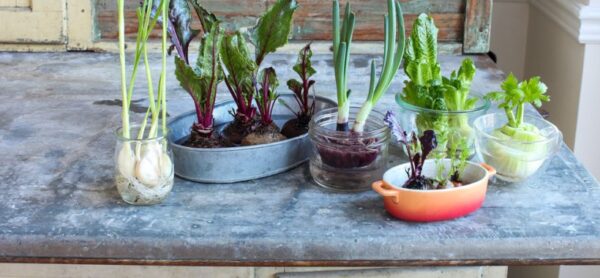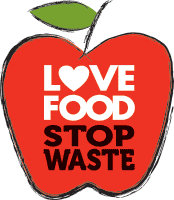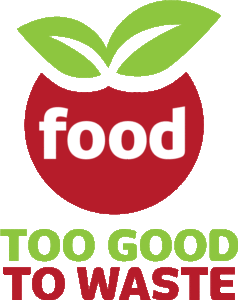
We throw away a lot of food! According to Seattle Public Utilities, Seattle residents throw out approximately 100,000 tons of food annually. Composting food waste is an important step in reducing this mountain of garbage that is now hauled 300 miles away for disposal in a landfill in Eastern Oregon. But you don’t have to throw all your food scraps into the yard waste bin! Some of these techniques may not make a huge reduction in the amount of food discarded, but they are fun and raise awareness about what we do with food we do not consider edible.
Use Your Scraps!
Trimmings from fresh fruits and vegetables and produce that have sat too long in the refrigerator are most often delegated to the worm or food waste collection bin. Fresh produce is not cheap! Put leek, fennel and carrot tops in an airtight bag in the freezer to use for soup stock at a later date. Have you ever bought a big bunch of parsley or cilantro and noticed it started to wilt before you were able to eat it all? Freeze and save for soups and sauces. The stems of asparagus, broccoli, chard, mushrooms and herbs will all add a flavor boost to stocks. Experiment with different ingredients. Sweeter vegetables like carrots may add more sweetness, onion skins and beet tops may add a touch of bitterness. Make a base for corn chowder by simmering corn cobs in a pot of boiling water. When you are done simmering those scraps into a delicious sauce or stock, feed them to the worms or dispose of them in your food and yard waste collection bin.
Creative cooks are coming up with new uses for fruit and vegetable scraps every day. Pickle watermelon rinds, turn herbs into flavored butters and oils or even make jelly out of apple cores and peels (no pectin needed!). Soft stems from many vegetables, like arugula and chard, can be turned into pesto. Shred stems and leaves from broccoli and cauliflower into a vegetable slaw. Wrap fish in corn husks and throw it on the grill. Zest citrus rinds and freeze for later use or dry out the peels in a dehydrator or 200°F degree oven, pulverize to a powder and store on the shelf. Use the powder in any recipe calling for dried citrus rind like a festive birthday cake.
Regrow From Your Scraps!
Another fun and educational way to reuse scraps from some fruits and vegetables is to grow them into food again! You will probably never harvest fruit from a tree grown from an avocado pit in the Pacific Northwest unless you have a large heated greenhouse, but it may make a nice houseplant. It is also true that you can plop a piece of potato from the grocery store in the ground and it will grow as long as there is an eye or two, but this can also be a way to spread disease. Purchase certified seed potatoes instead if you want to grow them to harvest.
Green onions, leeks, and fennel bulbs are easy to regrow. Place the white bulb end of the veggie into a glass jar filled with an inch of water, cutting the tops back to force fresh growth. Place near a sunny window. Let the green leafy part regrow and trim off leaves as you need them. Change the water weekly and you may be able to keep it going for a while. Another option is to let them grow a few weeks, then plant outside in a container or garden bed if the weather is warm enough. If it is still cold outside, harden off first to prevent the plant from going into shock moving from a cozy, warm windowsill to the outside world.
This technique can also be adapted to grow celery, Romaine lettuce hearts, Bok choy and cabbage from the root base you would otherwise compost. Rinse the cut-off base of the veggie in cool water and place in a bowl of warm water on a sunny windowsill with the base side down. The surrounding stalks may dry out, but the tiny center leaves should darken and get bigger. Change the water every few days. About a week later, plant in a container of soil and cover the base, leaving the leaf tips exposed to light. Celery needs lots of water, so don’t let it dry out. Continue to grow it inside or transplant to a garden bed after hardening off, depending on the weather.
Lemongrass can difficult to find in grocery stores so keep your supply growing at home. Buy lemon grass stalks with the roots attached at a market and once you have used the foliage place the leftover roots in a glass with water. Place on a sunny windowsill. The grass should start to grow back in about a week. Change the water every few days. If you want to transplant the lemongrass to a container, wait until it has put on a couple inches of roots to do so.
Ginger pairs nicely with lemongrass. It also does not like direct sunlight, so if you have filled up all of your sunny windowsills with plant scraps, try growing some ginger! Some people advise soaking the ginger in water for a few hours or overnight before planting in case it was treated with a growth retardant. Cut off a piece of the rhizome and put in a container filled with potting soil with the smallest buds facing up. Cover the piece with a few inches of soil. Use well-draining potting soil. Place away from direct sunlight but keep it warm. The top of a refrigerator might be a good spot. Ginger is a tropical plant that prefers a humid environment so be sure to mist your plant every few days. It will take 8-10 months to develop full flavor but can be dug up sooner. If it is transplanted outside, keep it mulched to keep it moist and bring it back in at the end of summer since they are tender in this area.
Keep your “food scrap garden” clean and safe by using scraps from organically or sustainably grown produce. When growing plants in containers, make sure your pots have drainage holes and use soil formulated for containers. Check the label for the words “Potting Soil” to make sure you have the best choice. Containers dry out more quickly than a garden bed, so be sure to monitor often. Poke your finger in the soil to check for dryness and water as needed. In general when the soil is dry to the touch about an inch down it is time to water again. Enjoy your recycled food scraps and maybe even experiment with other trimmings like beet and turnip tops.
King County and the City of Seattle are both actively working on programs to help us lessen our food waste imprint. Find more information at the following sites:
To chat one on one about ways to reduce, reuse and recycle your food scraps please contact the Garden Hotline at (206) 633-0224 or www.gardenhotline.org. You can also find us on Facebook, Twitter, Pinterest, Instagram, Flickr and YouTube.

 Food: Too Good To Waste
Food: Too Good To Waste